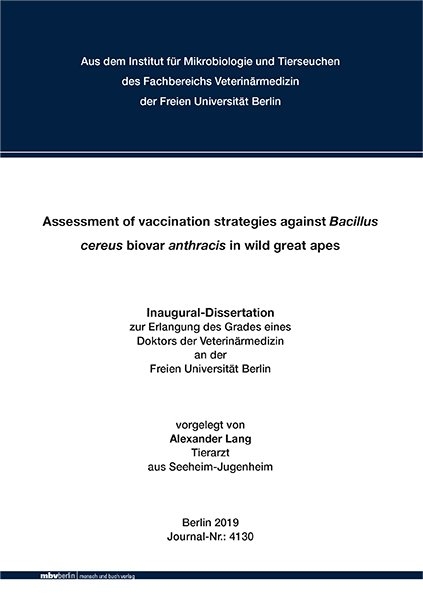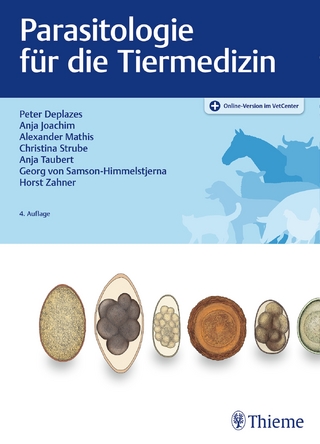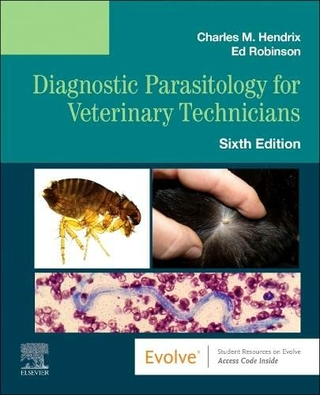
Assessment of vaccination strategies against Bacillus cereus biovar anthracis in wild great apes
Seiten
2020
|
1. Aufl.
Mensch & Buch (Verlag)
978-3-96729-038-7 (ISBN)
Mensch & Buch (Verlag)
978-3-96729-038-7 (ISBN)
- Keine Verlagsinformationen verfügbar
- Artikel merken
Besides poaching and habitat loss, infectious diseases can also contribute significantly towards the decline of threatened wildlife species. This is the case in Taï National Park (TNP) in Ivory Coast, where anthrax, caused by Bacillus cereus biovar anthracis (Bcbva), is a major contributing factor to the mortality of chimpanzees living there. Vaccination is an option to reduce the risk of contracting anthrax. However, the unique living conditions of wild chimpanzees in a dense tropical rainforest pose a major challenge for systematic vaccination. The use of blowpipes for vaccination had a negative effect on the otherwise neutral behavior of some habituated chimpanzees towards humans. Thus, the aim of this study was to assess whether vaccination by food bait is a possible non-invasive alternative. First, a suitable method for the application of the vaccine by food bait had to be established and the development of diagnostic assays for the detection of anthrax-specific antibodies in urine was necessary in order to be able to pursue a largely non-invasive approach for the planned study. The non-invasive assays were furthermore used to examine the success of the blowpipe vaccinations already carried out and the Bcbva seroprevalence in chimpanzees and sooty mangabeys.
ELISA and Western Blot protocols for the detection of anthrax-specific antibodies excreted via urine were developed using human serum and urine samples of anthrax vaccine recipients. For the comparative vaccination study in TNP, two different oral doses of the live spore vaccine Sterne 34F2 were tested in a group of habituated sooty mangabeys. In addition, mangabeys immunized by blowpipe and hand injection served as controls. After oral administration of the vaccine, no immune response was measurable and only two out of ten control animals had detectable antibodies after vaccination. When the vaccination campaign of 36 chimpanzees vaccinated by blowpipe was investigated, no reaction to the vaccine was observed. These observations question the use of Sterne 34F2 in chimpanzees and sooty mangabeys, not only for oral usage, but also fundamentally. Due to the lack of suitable alternative vaccines, there is currently no possibility of using vaccination to protect primates threatened by Bcbva. Another way to reduce the risk of infection is to identify and eliminate sources of infection. Further research is needed to understand the infection cycle and the involvement of possible vectors. One approach is the current investigation of potentially contaminated water and food sources, especially in the vicinity of deceased animals that have succumbed to anthrax.
The observed Bcbva seroprevalence was low in chimpanzees and sooty mangabeys. Only one chimpanzee was positive for antibodies against the protective antigen, a protein of the anthrax toxin. All urine samples available for this animal, collected over a period of twelve years, were positive. This suggests long lasting antibody production after Bcbva infection. The extent to which possible repeated non-lethal contact with Bcbva or anthrax toxin components acted as boosters and had a positive effect on detectability could, however, not be determined from the available data. Together with the high Bcbva mortality in TNP, the low seroprevalence indicates that Bcbva infections are mostly lethal. This observation is consistent with earlier studies on the virulence of Bcbva. "Evaluierung von Impfstrategien gegen Bacillus cereus biovar anthracis bei wildlebenden Menschenaffen"
Neben Wilderei und der Zerstörung von Lebensraum, können auch Infektionskrankheiten einen wesentlichen Teil zur Dezimierung von bedrohten Wildtierpopulationen beitragen. Dies ist der Fall im Nationalpark Taï (TNP) der Elfenbeinküste, in dem Anthrax, ausgelöst durch Bacillus cereus biovar anthracis (Bcbva), einen großen Anteil an der Mortalität der dort lebenden Schimpansen trägt. Impfung ist eine Option, das Risiko an Anthrax zu erkranken zu verringern. Die besonderen Lebensumstände von wildlebenden Schimpansen in einem dichten tropischen Regenwald stellen jedoch eine große Herausforderung für eine systematische Impfung dar. Der Einsatz von Blasrohren zur Impfung wirkte sich bei manchen habituierten Schimpansen negativ auf ihr ansonsten neutrales Verhalten Menschen gegenüber aus. Die vorliegende Studie sollte deshalb zeigen, ob eine Impfung per Futterköder eine mögliche nichtinvasive Alternative zur Blasrohrinjektion des Impfstoffes darstellt. Zu diesem Zweck musste nicht nur eine geeignete Methode zur Applikation des Impfstoffes per Futterköder gefunden werden, auch die Entwicklung diagnostischer Verfahren zum Nachweis von Anthrax-Antikörpern in Urin war nötig, um einen weitestgehend nichtinvasiven Ansatz für die geplante Studie verfolgen zu können. Mit den nichtinvasiven diagnostischen Methoden sollte außerdem der Erfolg der bereits durchgeführten Blasrohr-Impfungen und die Bcbva-Seroprävalenz bei Schimpansen und Rußmangaben untersucht werden.
Die ELISA und Western Blot Protokolle zum Nachweis von über den Urin ausgeschiedenen Anthrax spezifischen Antikörpern wurden mit Serum- und Urinproben von gegen Anthrax geimpften Menschen entwickelt. Für die vergleichende Impfstudie im TNP wurden in einer Gruppe habituierter, wildlebender Rußmangaben zwei unterschiedliche orale Dosierungen des Lebendimpfstoffes „Sterne 34F2“ getestet. Außerdem wurden Mangaben zur Kontrolle per Blasrohr und Handinjektion immunisiert. Nach oraler Gabe des Impfstoffes war keine Immunantwort messbar und nur in zwei von zehn Kontroll-Tieren konnte nach der Impfung eine Bildung von Antikörpern nachgewiesen werden. Bei der Überprüfung des Impferfolges von 36 per Blasrohr geimpften Schimpansen war keine Reaktion auf den Impfstoff feststellbar. Diese Beobachtungen stellen den Einsatz von „Sterne 34F2“ bei Rußmangaben und Schimpansen nicht nur bei oraler Gabe, sondern grundsätzlich in Frage. Aufgrund fehlender geeigneter alternativer Impfstoffe, gibt es zurzeit keine Möglichkeit, Impfungen als Schutz der von Bcbva bedrohten Primaten einzusetzen. Eine weitere Möglichkeit das Infektionsrisiko zu reduzieren besteht darin, Infektionsquellen zu identifizieren und zu beseitigen. Um den Infektionszyklus und die Beteiligung von möglichen Vektoren zu verstehen, bedarf es weiterer Forschung. Ein Ansatz hierfür ist die aktuelle Untersuchung potenziell kontaminierter Wasser- und Futterquellen, insbesondere in der Nähe an Anthrax verstorbener Tiere.
Die beobachtete Bcbva-Seroprävalenz war bei Schimpansen und Rußmangaben niedrig. Nur bei einem Schimpansen waren Antikörper gegen das Protektive Antigen des Anthraxtoxin-Komplexes nachweisbar. Alle für dieses Tier verfügbaren Urinproben, die während eines Zeitraums von zwölf Jahren gesammelt wurden, reagierten positiv. Dies spricht für langanhaltende Antikörperproduktion nach einer Infektion mit Bcbva. Inwieweit jedoch möglicher, wiederholter, subletaler Kontakt zu Bcbva oder Anthraxtoxin-Komponenten als Booster wirkte und die Nachweisbarkeit positiv beeinflusste, ließ sich anhand der vorhandenen Daten nicht bestimmen. Zusammen mit der hohen Bcbva Mortalität im TNP, spricht die niedrige Seroprävalenz dafür, dass Bcbva Infektionen meist letal verlaufen. Diese Beobachtung deckt sich mit früheren Studien zur Virulenz von Bcbva.
ELISA and Western Blot protocols for the detection of anthrax-specific antibodies excreted via urine were developed using human serum and urine samples of anthrax vaccine recipients. For the comparative vaccination study in TNP, two different oral doses of the live spore vaccine Sterne 34F2 were tested in a group of habituated sooty mangabeys. In addition, mangabeys immunized by blowpipe and hand injection served as controls. After oral administration of the vaccine, no immune response was measurable and only two out of ten control animals had detectable antibodies after vaccination. When the vaccination campaign of 36 chimpanzees vaccinated by blowpipe was investigated, no reaction to the vaccine was observed. These observations question the use of Sterne 34F2 in chimpanzees and sooty mangabeys, not only for oral usage, but also fundamentally. Due to the lack of suitable alternative vaccines, there is currently no possibility of using vaccination to protect primates threatened by Bcbva. Another way to reduce the risk of infection is to identify and eliminate sources of infection. Further research is needed to understand the infection cycle and the involvement of possible vectors. One approach is the current investigation of potentially contaminated water and food sources, especially in the vicinity of deceased animals that have succumbed to anthrax.
The observed Bcbva seroprevalence was low in chimpanzees and sooty mangabeys. Only one chimpanzee was positive for antibodies against the protective antigen, a protein of the anthrax toxin. All urine samples available for this animal, collected over a period of twelve years, were positive. This suggests long lasting antibody production after Bcbva infection. The extent to which possible repeated non-lethal contact with Bcbva or anthrax toxin components acted as boosters and had a positive effect on detectability could, however, not be determined from the available data. Together with the high Bcbva mortality in TNP, the low seroprevalence indicates that Bcbva infections are mostly lethal. This observation is consistent with earlier studies on the virulence of Bcbva. "Evaluierung von Impfstrategien gegen Bacillus cereus biovar anthracis bei wildlebenden Menschenaffen"
Neben Wilderei und der Zerstörung von Lebensraum, können auch Infektionskrankheiten einen wesentlichen Teil zur Dezimierung von bedrohten Wildtierpopulationen beitragen. Dies ist der Fall im Nationalpark Taï (TNP) der Elfenbeinküste, in dem Anthrax, ausgelöst durch Bacillus cereus biovar anthracis (Bcbva), einen großen Anteil an der Mortalität der dort lebenden Schimpansen trägt. Impfung ist eine Option, das Risiko an Anthrax zu erkranken zu verringern. Die besonderen Lebensumstände von wildlebenden Schimpansen in einem dichten tropischen Regenwald stellen jedoch eine große Herausforderung für eine systematische Impfung dar. Der Einsatz von Blasrohren zur Impfung wirkte sich bei manchen habituierten Schimpansen negativ auf ihr ansonsten neutrales Verhalten Menschen gegenüber aus. Die vorliegende Studie sollte deshalb zeigen, ob eine Impfung per Futterköder eine mögliche nichtinvasive Alternative zur Blasrohrinjektion des Impfstoffes darstellt. Zu diesem Zweck musste nicht nur eine geeignete Methode zur Applikation des Impfstoffes per Futterköder gefunden werden, auch die Entwicklung diagnostischer Verfahren zum Nachweis von Anthrax-Antikörpern in Urin war nötig, um einen weitestgehend nichtinvasiven Ansatz für die geplante Studie verfolgen zu können. Mit den nichtinvasiven diagnostischen Methoden sollte außerdem der Erfolg der bereits durchgeführten Blasrohr-Impfungen und die Bcbva-Seroprävalenz bei Schimpansen und Rußmangaben untersucht werden.
Die ELISA und Western Blot Protokolle zum Nachweis von über den Urin ausgeschiedenen Anthrax spezifischen Antikörpern wurden mit Serum- und Urinproben von gegen Anthrax geimpften Menschen entwickelt. Für die vergleichende Impfstudie im TNP wurden in einer Gruppe habituierter, wildlebender Rußmangaben zwei unterschiedliche orale Dosierungen des Lebendimpfstoffes „Sterne 34F2“ getestet. Außerdem wurden Mangaben zur Kontrolle per Blasrohr und Handinjektion immunisiert. Nach oraler Gabe des Impfstoffes war keine Immunantwort messbar und nur in zwei von zehn Kontroll-Tieren konnte nach der Impfung eine Bildung von Antikörpern nachgewiesen werden. Bei der Überprüfung des Impferfolges von 36 per Blasrohr geimpften Schimpansen war keine Reaktion auf den Impfstoff feststellbar. Diese Beobachtungen stellen den Einsatz von „Sterne 34F2“ bei Rußmangaben und Schimpansen nicht nur bei oraler Gabe, sondern grundsätzlich in Frage. Aufgrund fehlender geeigneter alternativer Impfstoffe, gibt es zurzeit keine Möglichkeit, Impfungen als Schutz der von Bcbva bedrohten Primaten einzusetzen. Eine weitere Möglichkeit das Infektionsrisiko zu reduzieren besteht darin, Infektionsquellen zu identifizieren und zu beseitigen. Um den Infektionszyklus und die Beteiligung von möglichen Vektoren zu verstehen, bedarf es weiterer Forschung. Ein Ansatz hierfür ist die aktuelle Untersuchung potenziell kontaminierter Wasser- und Futterquellen, insbesondere in der Nähe an Anthrax verstorbener Tiere.
Die beobachtete Bcbva-Seroprävalenz war bei Schimpansen und Rußmangaben niedrig. Nur bei einem Schimpansen waren Antikörper gegen das Protektive Antigen des Anthraxtoxin-Komplexes nachweisbar. Alle für dieses Tier verfügbaren Urinproben, die während eines Zeitraums von zwölf Jahren gesammelt wurden, reagierten positiv. Dies spricht für langanhaltende Antikörperproduktion nach einer Infektion mit Bcbva. Inwieweit jedoch möglicher, wiederholter, subletaler Kontakt zu Bcbva oder Anthraxtoxin-Komponenten als Booster wirkte und die Nachweisbarkeit positiv beeinflusste, ließ sich anhand der vorhandenen Daten nicht bestimmen. Zusammen mit der hohen Bcbva Mortalität im TNP, spricht die niedrige Seroprävalenz dafür, dass Bcbva Infektionen meist letal verlaufen. Diese Beobachtung deckt sich mit früheren Studien zur Virulenz von Bcbva.
| Erscheinungsdatum | 29.06.2020 |
|---|---|
| Verlagsort | Berlin |
| Sprache | englisch |
| Maße | 148 x 210 mm |
| Themenwelt | Veterinärmedizin ► Allgemein |
| Veterinärmedizin ► Klinische Fächer ► Parasitologie | |
| Schlagworte | Anthrax • antibodies • Bacillus cereus • cercocebus torquatus • Chimpanzees • Côte d’Ivoire • ELISA • epidemiology • Urine • urine analysis • Vaccination • Western blotting |
| ISBN-10 | 3-96729-038-7 / 3967290387 |
| ISBN-13 | 978-3-96729-038-7 / 9783967290387 |
| Zustand | Neuware |
| Informationen gemäß Produktsicherheitsverordnung (GPSR) | |
| Haben Sie eine Frage zum Produkt? |
Mehr entdecken
aus dem Bereich
aus dem Bereich
Buch | Spiralbindung (2022)
Mosby (Verlag)
CHF 132,65


